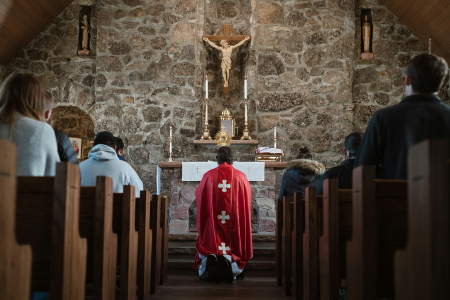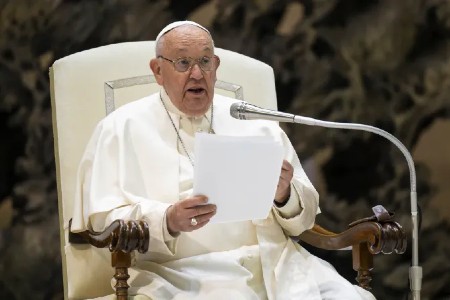Our Lady of Charity of the Good Shepherd
FREE Catholic Classes
The aim of this institute is to provide a shelter for girls and women of dissolute habits, who wish to do penance for their iniquities and to lead a truly Christian life. Not only voluntary penitents but also those consigned by civil or parental authority are admitted. Many of these penitents desire to remain for life; they are admitted to take vows, and form the class of "magdalens", under the direction of the Sisters of the Good Shepherd. They are an austere contemplative community, and follow the Rule of the Third Order of Mount Carmel. Prayer, penance and manual labour are their principal occupations. Many of these "magdalens" frequently rise to an eminent degree of sanctity. Besides girls and women of this class, the order also admits children who have been secured from danger, before they have fallen or been stained by serious crime. They are instructed in habits of industry and self-respect and in all the duties they owe to themselves and to society. The "penitents", "magdalens" and "preservates" form perfectly distinct classes, completely segregated from one another.
The Good Shepherd is a cloistered order and follows the Rule of St. Augustine. The constitutions are borrowed in great part from those given by St. Francis of Sales to the Visitation Sisters, but are modified to suit the nature of this work. Besides the three ordinary vows of poverty, chastity and obedience, the Sisters of the Good Shepherd take a fourth vow, namely, to work for the conversion and instruction of "penitents",--a vow which makes this order one of the most beautiful creations of Christian charity. The vows are renewed every year, for five years, before becoming perpetual. The order is composed of choir sisters, and lay or "converse" sisters. The choir sisters recite every day the Little Office of the Blessed Virgin . The habit is white, with white scapulars reminding them of the innocence of the life they should lead. The choir sisters wear a black veil; the "converse" sisters a white veil. Around their necks, they wear a silver heart, on one side of which is engraved an image of "The Good Shepherd" and on the other, the blessed virgin holding the Divine Infant, between a branch of roses and a branch of lilies. The heart represents that of the sister, consecrated to Mary and to her Divine Son and the roses and liles are symbolical of the virtues of charity and purity. The order is dedicated in an especial manner to the Holy Heart of Mary and to the Sacred Heart of Jesus, which are its two patrons. Besides the choir sisters and the "converse" sisters, the order also admits "Tourière" Sisters, who attend to the door and perform necessary duties outside the cloister. Their habit is black, and they take only the three ordinary vows.
 Hi readers, it seems you use Catholic Online a lot; that's great! It's a little awkward to ask, but we need your help. If you have already donated, we sincerely thank you. We're not salespeople, but we depend on donations averaging $14.76 and fewer than 1% of readers give. If you donate just $5.00, the price of your coffee, Catholic Online School could keep thriving. Thank you. Help Now >
Hi readers, it seems you use Catholic Online a lot; that's great! It's a little awkward to ask, but we need your help. If you have already donated, we sincerely thank you. We're not salespeople, but we depend on donations averaging $14.76 and fewer than 1% of readers give. If you donate just $5.00, the price of your coffee, Catholic Online School could keep thriving. Thank you. Help Now >
The Institute of the Good Shepherd is a branch of "Our Lady of Charity of the Refuge", founded by Blessed John Eudes, at Caen, France, in 1641, and approved by Alexander VII, 2 January, 1666, its constitutions being approved by Benedict XIV, in 1741. The order as primitively organized by blessed John Eudes still exists in a flourishing state, under the first title of "Our Lady of Charity of the Refuge", and counts about thirty-nine houses and about 1893 sisters. The distinction between the primitive order and its branch, the Institute of "Our Lady of Charity of the Good Shepherd", consists mainly in the administration. According to the custom of his time, the Blessed John Eudes ordained that "Our Lady of the Refuge" should have no mother-house, but that every house founded by this order should be a distinct community, having its own administration, and being united to the other houses only by bonds of fraternal charity.
Among the noble women who entered the ranks of the Sisters of the refuge in the nineteenth century was one whose name will be long remembered, Mother Mary Euphrasia Pelletier. She was born in the island of Noirmoutier of pious parents, on 31 July 1796, and received in baptism the name of Rose Virginia. She entered the community of "The Refuge" of Tours, in 1814, and made her profession in 1816, taking the name of Mary St. Euphrasia. She became first mistress of the penitents, a short time after her profession, and about eight years later was made superioress of the house of Tours. Desirous of extending the benefits of her order to the very extremities of the earth, she clearly saw that a central government, a mother-house, should be established.
The house of Angers, which she had founded, seemed destined by God for grand designs. He would decide, by the voice of His pontiff. Like many of God's elect, she was treated by her adversaries as an innovator, an ambitious person, impatient of authority. Only after incessant labours and formidable opposition did her cause triumph. The Brief in approval of the mother-house at Angers was signed 3 April, 1835, and published by Gregory XVI. The official title of the institute was henceforth "Our Lady of Charity of the Good Shepherd of Angers". It is directly subject to the Holy See, and Cardinal Odescalchi was its first cardinal-protector. Angers is authorized to send its sisters to the extremities of the earth. Mother Euphrasia heartily devoted herself to the work entrusted to her. She had been accused of ambition, of innovation, and of disobedience. Her sole ambition was to extend God's kingdom, and to offer the benefits of her institute to the whole world. Her innovations, in harmony with the spirit of the Gospel, with the fourth vow of her order, were approved by the Church, and gave in thirty-three years one hundred and ten soul-saving institutions to the Church and to society. Her institutions were all founded in obedience to the requests of ecclesiastical authorities in every part of the world. Thirty-three years she was mother-general of the Good Shepherd, and at her death 29 April 1868, she left 2067 professed sisters, 384 novices, 309 Touriere sisters, 962 "Magdalens", 6372 "penitents", and 8483 children of various classes. Angers had seen great changes since 1829, when Mother Euphrasia had come with five sisters to found the house. Within thirty-three years one hundred and ten convents had been founded, sixteen provinces established, in France, Belgium, Holland, Rome, Italy, Germany, Austria, England, Scotland, Ireland. Asia, Africa, the United States and Chili. Under her successor, Mother Mary St. Peter Coudenhove, in twenty-four years, eighty-five houses were founded, and thirteen new provinces established, making eleven in Europe, two in Africa, nine in North America, five in South America and one in the Oceania.
The cause of the beatification of Mother Euphrasia was inscribed by the postulator of the cause, 17 Nov., 1886. The preliminary examination terminated in 1890. Leo XIII received supplications from numerous cardinals, archbishops, bishops, several cathedral chapters, rectors of colleges, and universities, hundreds of priests, and many noble families, begging him to dispense from ordinary ten years' interval required before the continuation of the cause. On 11 Dec., 1897, Leo XIII declared her "Venerable", to the great joy of the whole world, and to the honour and glory of all the convents of the Good Shepherd.
The order glories also in the name of Mother Mary of the Divine Heart, who has been compared to the Blessed Margaret Mary Alacoque. The consecration of the universe to the Sacred Heart, 9 June, 1899, which Leo XIII referred to as the greatest act of his pontificate, was brought about by her suggestion. She died on the eve of the consecration (8 June, 1899), at Porto, Portugal, and already preparations are being made for her beatification.
Join the Movement
When you sign up below, you don't just join an email list - you're joining an entire movement for Free world class Catholic education.
-

-
Mysteries of the Rosary
-
St. Faustina Kowalska
-
Litany of the Blessed Virgin Mary
-
Saint of the Day for Wednesday, Oct 4th, 2023
-
Popular Saints
-
St. Francis of Assisi
-
Bible
-
Female / Women Saints
-
7 Morning Prayers you need to get your day started with God
-
Litany of the Blessed Virgin Mary
U.S. Catholic Parishes Experience Resurgence of Traditional Practices
-

Pope Francis Urges Faith and Prayers for Peace
-

Florida Welcomes Volunteer Chaplains to Public Schools
-
10 Fascinating Details About St. Joseph the Worker: Celebrating His Feast Day - May 1
-
St. Joseph the Worker: Model for Men, Young and Old
Daily Catholic
 Daily Readings for Thursday, May 02, 2024
Daily Readings for Thursday, May 02, 2024 St. Athanasius: Saint of the Day for Thursday, May 02, 2024
St. Athanasius: Saint of the Day for Thursday, May 02, 2024 The Our Father: Prayer of the Day for Thursday, May 02, 2024
The Our Father: Prayer of the Day for Thursday, May 02, 2024- Daily Readings for Wednesday, May 01, 2024
- St. Marculf: Saint of the Day for Wednesday, May 01, 2024
- To Saint Peregrine: Prayer of the Day for Wednesday, May 01, 2024
![]()
Copyright 2024 Catholic Online. All materials contained on this site, whether written, audible or visual are the exclusive property of Catholic Online and are protected under U.S. and International copyright laws, © Copyright 2024 Catholic Online. Any unauthorized use, without prior written consent of Catholic Online is strictly forbidden and prohibited.
Catholic Online is a Project of Your Catholic Voice Foundation, a Not-for-Profit Corporation. Your Catholic Voice Foundation has been granted a recognition of tax exemption under Section 501(c)(3) of the Internal Revenue Code. Federal Tax Identification Number: 81-0596847. Your gift is tax-deductible as allowed by law.









 Daily Readings for Thursday, May 02, 2024
Daily Readings for Thursday, May 02, 2024 St. Athanasius: Saint of the Day for Thursday, May 02, 2024
St. Athanasius: Saint of the Day for Thursday, May 02, 2024 The Our Father: Prayer of the Day for Thursday, May 02, 2024
The Our Father: Prayer of the Day for Thursday, May 02, 2024

